Related Blogs
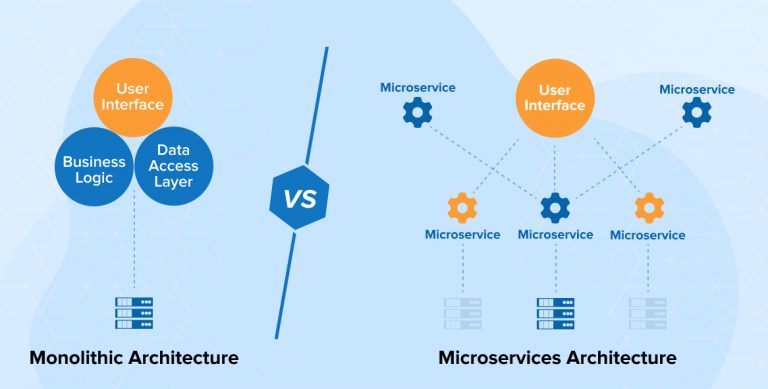
One of the first things a developer must decide when developing a new application is whether to use a monolithic approach or microservices architecture. Both the monolithic and the microservices approach allows software development companies to develop dependable programs for a wide range of uses, but their underlying structures are significantly different. What follows is an explanation of the key differences between monolithic vs microservices architectures as well as examples of when either approach might be appropriate.
1. What is a Monolith?
Monolithic Application, also referred as “Monolith”, is an application that is built using a single code base that contains all the functionalities. This single codebase includes all the components such as backend code, frontend code, configuration files, and everything. These apps are primarily developed to perform a number of interconnected functions.
Monolithic architecture is a traditional approach for developing an application. Many businesses moved from Monolith to the modern Microservices architecture pattern but some businesses still benefit by using the Monolith pattern. For example, if the project has small team size, or the scope of the application is limited, then Monoliths suits best as it’s easy to develop and deploy. However, there are many challenges one can face like scalability, difficulty in debugging, etc. while using this pattern.
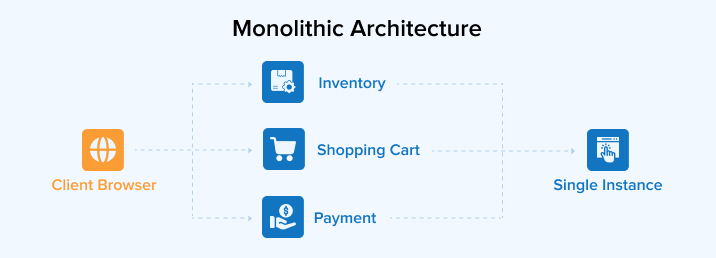
2. What is Microservices Architecture?
Microservices architecture is an alternative to monolithic design. In this pattern, the entire codebase is splitted into smaller and independent components that perform a single specific task. Each component here can be developed, tested, deployed, and scaled independently. These components can also communicate with one another using Application Programming Interface (APIs).
Microservices are easier to create and test from a software engineering point of view. Development teams can make faster progress due to continuous integration and continuous delivery (CI/CD).
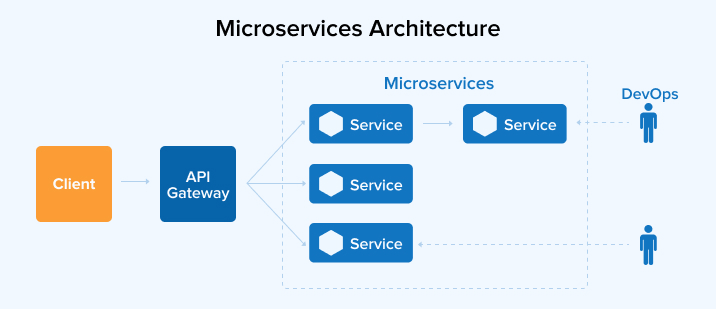
Further Reading on: Microservices Best Practices
3. Monolithic vs Microservices: Key Differences
Let’s examine Microservices vs Monolithic architectures and compare each distinguishing component in detail.
3.1 Architecture
A monolith is a single, homogeneous construct of software. There are typically three components: client side user interface, a database, and server-side program. All HTTP requests and the actual processing of business logic are typically handled by the server-side application. Server-side logic, user interface logic, batch tasks, etc. are all included within a single EAR, WAR, or JAR file in monolithic architectures.
Whereas, a microservices architecture separates broad categories of functionality and business operations into micro, and more manageable components. Each service may be built separately from the rest, has its own database, and interacts with other services via API endpoints.
The goal of this architectural approach is to construct a complex system out of smaller service suites. To make this work, each microservice runs its own processes and makes use of lightweight communication channels, such as APIs for accessing resources through the HTTP protocol. These microservices are deployed and managed separately from one another, and each is created separately around the business logic.
3.2 Use Cases
Monolithic Architecture
| Use Case | |
|---|---|
| Small application | With monolith, you can develop small and simple apps rapidly. With a single codebase to maintain, you can expect a quick turnaround. |
| Ideation phase | Monolith is the best option if you are still researching and finalizing the functionalities to develop. It allows rapid iteration, and you can always switch to microservices as your business expands. |
| Limited Scope | When the application has a limited scope to add functionalities, this software architecture works best. |
| Minimum Viable Product (MVP) | With a monolithic approach, you may rapidly develop and deliver a minimum viable product (MVP) for testing and user feedback. This is useful in general, but it helps much more in a highly competitive market. |
| Limited tech expertise | A monolithic application has a single codebase and it is developed using limited technologies. So, it becomes easier to find the talent according to the project needs. |
Microservices Architecture
| Application | |
|---|---|
| Large-scale applications | Microservices architecture is a best fit for the Large scale applications. One can divide the whole application into smaller & independent services & components and eventually it will make the entire application development much easier. |
| Big data applications | The design of big data applications is based on a complicated pipeline, with individual stages responsible for the management of individual tasks. So, Microservices Architecture works best for the development. |
| Complex and evolving applications | Microservices aid in the adaptation of programs to the ever-changing environment brought on by the proliferation of new programming languages and other technological advancements. |
| Real-time data processing applications | Microservices, with their publish-subscribe communications structure, are well-suited to develop real time data processing applications. |
3.3 Deployment Strategies
The scalability of software at the enterprise level is well-known to be a strength of any architecture. While the monolithic architecture pattern has seen widespread adoption, many businesses are having trouble devising a plan to overcome significant obstacles, such as deconstructing it into a microservices-based application.
For the Monolithic application deployment, multiple identical copies of the application run on multiple servers. It can be done by equipping N number of virtual or physical servers and executing all the instances of an application. There might be hundreds of services in a microservices application, all of which were developed using different programming languages and tools. Each service acts like a standalone program and has its own set of requirements for things like deployment, scalability, and monitoring.
Although still in its infancy, the microservice architecture offers a promising new approach to app development. When building a microservices-based application, you’ll need in-depth knowledge of the several microservices frameworks and programming languages used by the individual services. It’s a significant obstacle because every service has its own requirements for deployment, resources, scalability, and monitoring.
Services for deployment should be efficient in time and money invested. In order to cope with a flood of requests from several interconnected parts, most microservice deployment techniques are readily scalable. Various options for deploying microservices are outlined here so that you may select the best fit for your company’s needs.
1. Multiple Service Instances Per Host
Deploy Multiple Services or multiple instances of different services on a single host. Host can be either a physical or a virtual machine.
There are various ways for the deployment of service instances:
- Deploy every individual microservice instance as a JVM process.
- Deploy multiple microservice instances in the same JVM.
Deploy each microservice on its own host.
The key benefits one can get using this approach are:
- Each service is isolated from another one.
- Rare possibility of conflicting dependency and resource requirements.
- Easy to Manage, test, monitor, and redeploy each service.
Deploy each microservice directly on the deployment infrastructure. This method hides the concept of deployment on physical or virtual hosts or containers. The deployment infrastructure is mainly operated by a cloud service provider. It uses inbuilt containers or virtual machines to isolate the microservices. For this kind of deployment, one is not required to manage physical hosts, virtual servers, operating systems, etc.
Some examples of serverless deployment environments are:
- AWS Lambda
- Azure Functions
- Google Cloud Functions
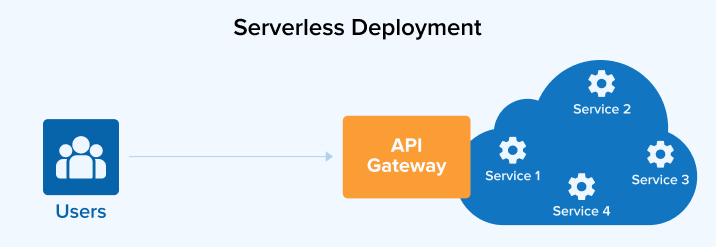
Deploy each service as a container by packaging it as a docker (container) image.
Key benefits:
- Containers are fast to build and run.
- By changing the number of container instances, one can easily scale up or down any microservice.
- Each service is isolated from another one.
- Internal details of the microservice are encapsulated by the container.
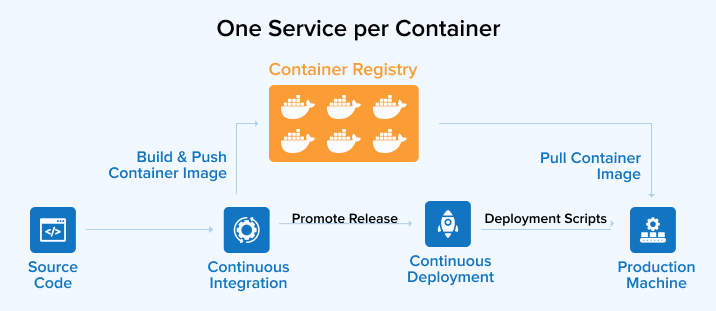
3.4 Cost
The term “cost” encompasses several different considerations. The total cost of ownership includes the initial investment, as well as the costs of maintenance, progression, durability, performance, and productivity. When making the ultimate choice to implement any software design, cost is a major element that comes to the minds of executives.
Monolithic architecture would cost less in case of MVP (Minimum Viable Product) development, small applications creation, initial phase of an application, smaller team size, limited technical expertise, etc. while Microservices architecture would cost comparatively less in case of complex application development.
3.5 Scalability
There are a number of different techniques to adjust the size of a monolith. Using a load balancer to send requests to various virtual machines is one option.
By decomposing the entire application into smaller services, microservices architecture provides more flexibility and scalability. Each service can be scaled vertically as well as horizontally. There are a variety of methods and tools available to scale the microservice in both ways. Amazon Elastic Container Service, Docker, Kubernetes, and Amazon Elastic Container Service are just a few of the widely used tools out there. Microservices are the best option for exact scaling and efficient resource use.
3.6 Monolithic vs Microservices Architecture: Advantages and Disadvantages
Let’s first go through the advantages of both the architectures:
Monolithic Architecture:
| Advantage | |
|---|---|
| Reduced number of intersecting issues | If the application size is small, then it will be easier for developers to solve the issues since there are fewer difficulties that cut across several components. |
| Simple testing | For smaller applications, testing would be easier since there is just one component to debug and test. |
| Lower costs associated with running the business | The operational overheads of a microservices design can be avoided with a monolithic approach. |
| Consistently effective operation | Since there is no interservice communication, the improved performance is due to the consolidated code and memory. |
| Faster development for small application | One can reduce overall application development time if the application has fewer functionalities to develop. |
| Deployment made easier | The simplicity of deployment is mostly due to the reduced number of moving components required and less complexity. |
Microservices Architecture:
| Advantage | |
|---|---|
| Easier scaling | The scalability of microservices is far superior to that of monoliths. When necessary, you can quickly update specific components. |
| Independent deployment | Because of the decentralized nature of the microservices design, individual development teams can work on and release new modules with relative ease. |
| Failure isolation | Unlike monoliths, where a single flaw may bring down the entire system, microservices can be brought down individually. So, the probability of failing an entire application is very less. |
| Tech agnostic | With microservices, the team may pick the most appropriate technology for each individual service. |
| Easier organization and management | The DevOps-favored organization of smaller, cross-functional teams might be reflected in the microservices architecture. As a result, departments may have complete control over their own section of the program. |
Now, let’s see the disadvantages of both the architectures:
Monolithic Architecture:
| Disadvantage | |
|---|---|
| Less flexibility in technology | Monolithic apps struggle to remain competitive due to the difficulty of adopting new technology. |
| Intricate Maintenance | At size, maintenance of monoliths is exceptionally difficult since even modest changes influence the whole codebase. |
| Slow Development | Once you get through the first few levels of development, progress begins to slow down. |
| It’s hard to scale up | There is a geometric increase in the difficulty of running and maintaining the codebase as its size increases. |
| Weak in dependability | Monolithic applications are notoriously unreliable due to the fact that a single failure may cripple the whole system. |
| Complex adoption for third-party tools | Monolithic apps aren’t great for integrating other resources since it’s difficult to connect external tools to a single codebase with various dependencies. |
Microservices Architecture:
| Disadvantage | |
|---|---|
| Concerns about safety | There is a possibility of leakage of sensitive information as many teams may work on the same project. |
| Increased Network Traffic | Since microservices are designed to be self-contained, they rely heavily on the network to communicate with each other. This can result in slower response times (network latency) and increased network traffic. |
| Too many cross-cutting concerns | Synergy between the various parts may be difficult to achieve without proper implementation. |
| High operational overheads | For Complex systems, there is a bigger team required to develop microservices architecture. Eventually, it costs more to the business. |
Below is the Statista survey report for the Microservices architecture:

4. When to Use the Microservice Architecture?
Knowing when it’s appropriate to employ this architecture is difficult. The issues that this method addresses are not always present while creating the initial version of an app. More so, development time will increase when a complex distributed architecture is used. Startups frequently have the greatest obstacle in fast evolving the business model and supporting applications, therefore this might be a serious issue for them.
While vertically decomposing the monolith application, quick iterations can be more difficult. Therefore, when the problem is how to scale while employing functional decomposition, you may find it challenging to break down your monolithic application into a collection of services due to the complexity introduced by the intertwined dependencies. The founder of Microservices.io Chris Richardson is adding more value to it via his tweet.
Monolith First is generally good advice. But it’s not universally applicable. Sometimes it might make sense to start with microservices. To understand why, let’s analyze the trade-offs using dark energy and dark matter. pic.twitter.com/zrXfy13DMH
— Chris Richardson (@crichardson) November 29, 2022
| Monolith Architecture | Microservices Architecture | |
|---|---|---|
| Ease of Operation | Good for small applications | Good for large applications |
| Ideation Phase | Yes | |
| Minimum Viable Product | Yes | |
| Ease of Testing | Yes | |
| Large and Complex applications | Yes | |
| Scalability | Yes | |
| Cost Effectivity | For small applications | For large applications |
| Technology Flexibility | Yes | |
| Ease of Deployment | Easy in case of small applications | Easier for Large applications |
| Limited Tech Expertise | Yes | |
| Ease of Debugging | Yes | |
| System Reliability | Yes |
5. Tips to Migrate From Monolithic Architecture to Microservice Architecture
The process of transferring or refactoring the monolithic application into Microservices based application is called Application Modernization. First, verify that your software delivery issues are caused by outgrowing your monolithic design before making the switch to a microservices model. If you can enhance your software development process, you may be able to shorten the time it takes to release.
The monolith may be strangled and replaced by microservices in three basic ways:
- Add functionalities as a service.
- Divide the front-end from the back-end.
- Remove the complexity of the monolith by splitting features into separate services.
The first tactic is used to halt the expansion of the monolith. It’s a fast approach to proving microservices’ worth and winning over skeptics ahead of a larger move. Other two methods dismantle the giant structure. The third technique, in which a feature is transferred from the monolith into the strangler application, is the one you will always employ when reworking your monolith. You can get clear picture from Bilgin Ibryam‘s tweet.
[Video] AWS Serverless architectural patterns and best practices (ARC307-R3) https://t.co/jAs5tTHpoh pic.twitter.com/Xw9Aaq3fyW
— Bilgin Ibryam (@bibryam) November 19, 2022
Subsequently moving the monolith’s functions into separate services is the primary strategy for decomposing it. Getting the most valuable services out of a system should be a top priority. Whenever a new service is created, it will inevitably have to communicate with the monolith.
Supporting both the in-memory session-based network security of the monolithic application and the token-based system security of the services is required during remodeling to a microservice architecture.
An easy workaround is to have the API gateway send security tokens included in cookies generated by the monolith’s login handler.
Here are some of the most followed considerations to keep in mind while in the migration phase.
5.1 Build Optimization
Time and space have been occupied by monoliths. The first thing to do is simplify your development process. The build will be more stable if you take off the external elements and dependencies that are causing problems.
5.2 Decouple the Dependencies
The modular dependencies of the monoliths should be eliminated once the build process has been simplified. If you want to reach such a level of separation in your code, you might need to rework it.
5.3 Enhance Regional Growth
The development, deployment, and testing processes on the local development environment should go more quickly. It’s important to adopt Docker and similar tools at the neighborhood level as well. Tasks like installing a local database, etc., are sped up as a result.
5.4 Expanding in a Concurrent Manner
It is recommended to split the code repository into multiple branches, one for each microservice. Because of this configuration, all monoliths may be developed simultaneously, which will boost the agility of software development lifecycle (SDLC).
5.5 Adopt Infrastructure as Code (IaC)
A more standardized and reliable infrastructure is made possible by IaC adoption. With the support of a realistic approach to environment construction, developers may bring the cloud closer to their computers.
While introducing new features as services is tremendously valuable, the only means of eradicating the monolith is to systematically remove modules from the monolith and transform them into services.
For example, let’s say that your team wishes to increase the productivity of the company and client happiness by swiftly repeating the courier scheduling algorithm. It will be a way simpler for them to concentrate on the delivery management logic if it’s a distinct Delivery Service. To achieve that, the team needs to decouple delivery management from order management and transform it into operation.
Here’s a graphical representation of how your team can ace the process:
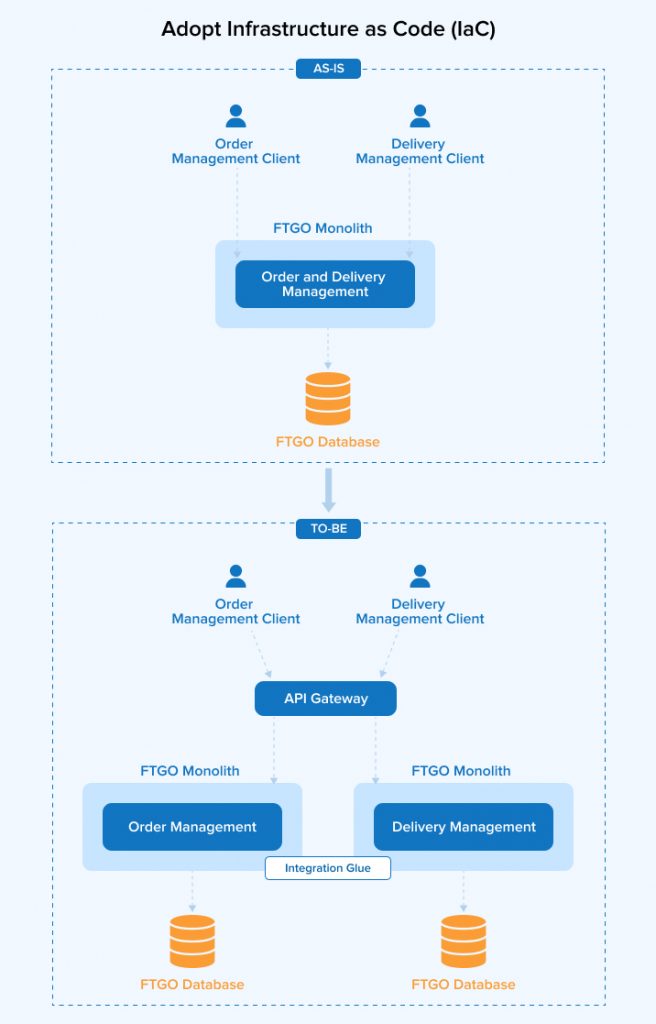
6. Companies Migrated From Monolithic to Microservices
Numerous leading tech firms have migrated from monolithic to microservices and there are many reasons for it. Here are the top three examples:
6.1 Amazon
The retail website of Amazon had a monolithic architecture with multi-tiered services and tightly interwoven connections. With the increase in their customer base, their development team became bigger and so did their codebase. But the upgrades and modifications kept getting complicated. Adding overheads to the process slowed down the SDLC.
Moreover, the service interdependencies and coding challenges were restraining Amazon’s ability to scale up to keep up with its expanding user base and its requirements. That’s when Amazon decided to split its monolithic app into a set of small and independent services.
They started by analyzing and isolating the source code into a single unit function. Then a web service interface was used to wrap those units. After separating and forming independent services, a developer team was assigned to each service. It helps get a granular view of the development process and swiftly removes the bottlenecks.
Adopting the microservices architecture made it easy for them to develop and deliver solutions such as Apollo and AWS to other organizations.
6.2 Twitter
Twitter has one of the largest codebases in the world and it ran all its public APIs on a monolithic RoR app. The company was facing challenges in updating the Twitter teams so they migrated to 14 microservices running on Macaw which is an internal JVM-based framework. It did improve their deployment time but the public API was scattered and disjointed.
The app’s decoupled architecture where teams worked separately and services were created individually with little coordination resulted in fragmentation and slowed productivity. As a solution, Twitter released a new public API and built a new architecture that can use GraphQL-based internal APIs. This makes it easy to iterate and scale quickly to large endpoints.
The development of pluggable platform components made Twitter’s architecture more efficient. They help with the APIs’ HTTP requirements so that developers can release new APIs quickly without constructing new HTTP services.
6.3 Netflix
Similar to Amazon, Netflix is also a pioneer in microservices and opted to migrate from a monolithic architecture when faced with service outages and scaling issues. They started by moving from their data centers’ relational databases and other vertically scaled single points of failure.
Netflix later adopted horizontally scalable cloud-based distributed systems that were very reliable. The streaming platform picked AWS as its cloud provider. One by one Netflix refactored all services and moved them on to operate on the AWS cloud using a standalone microservices architecture.
Adopting microservices helped Netflix reduce its costs significantly and overcome many challenges. Nowadays, Netflix offers streaming services to hundreds of millions of subscribers worldwide and they can do it without any operational challenges, thanks to microservices architecture.
7. Conclusion
Adopting a microservices architecture is a challenging move. Not all architectures are same. The same is true for software, which can vary widely. The idea is to gradually implement microservices and the related technologies and techniques. Microservice architectures shine when used with advanced software that is constantly changing. Adopting microservices, however, will be an immense challenge without the necessary knowledge and experience with these tools.
This article compares two common types of software architectures, microservices and monoliths, to help you decide which is best for your needs. In the end, you’ll need to settle on a strategy that’s most effective in your particular setting. But have no worry; that’s exactly why we exist! Never hesitate to call upon us for assistance.
FAQs
What is Difference between Microservices and Monolithic?
The key difference between monolithic and microservices architecture is that a monolithic app functions as a centralized unit with a single codebase. Meanwhile, microservices architecture is an integration of multiple small and independent services.
Is Netflix a Monolithic or Microservices?
Initially, Netflix was hosted on a monolithic architecture, but it was not able to keep up with the growing demand for its streaming services. To resolve all the growing issues, Netflix migrated entirely to a horizontally scalable cloud-based microservices architecture. The company currently boasts over a thousand microservices.
Are Microservices Faster than Monolithic?
An API performs the same function in a centralized codebase as it does in microservices. But because a monolithic app is a single unit, it can work faster in comparison to distributed microservices apps.

Vishal Shah
Vishal Shah has an extensive understanding of multiple application development frameworks and holds an upper hand with newer trends in order to strive and thrive in the dynamic market. He has nurtured his managerial growth in both technical and business aspects and gives his expertise through his blog posts.
Subscribe to our Newsletter
Signup for our newsletter and join 2700+ global business executives and technology experts to receive handpicked industry insights and latest news
Build your Team
Want to Hire Skilled Developers?





There are so many debates going on about what to choose between monolithic and microservices architecture. This insight cleared my doubt at some extent.